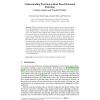Free Online Productivity Tools
i2Speak
i2Symbol
i2OCR
iTex2Img
iWeb2Print
iWeb2Shot
i2Type
iPdf2Split
iPdf2Merge
i2Bopomofo
i2Arabic
i2Style
i2Image
i2PDF
iLatex2Rtf
Sci2ools
RAID
2007
Springer
2007
Springer
Understanding Precision in Host Based Intrusion Detection
Abstract. Many host-based anomaly detection systems monitor process execution at the granularity of system calls. Other recently proposed schemes instead verify the destinations of control-flow transfers to prevent the execution of attack code. This paper formally analyzes and compares real systems based on these two anomaly detection philosophies in terms of their attack detection capabilities, and proves and disproves several intuitions. We prove that for any system-call sequence model, under the same (static or dynamic) program analysis technique, there always exists a more precise control-flow sequence based model. While hybrid approaches combining system calls and control flows intuitively seem advantageous, especially when binary analysis constructs incomplete models, we prove that they have no fundamental advantage over simpler control-flow models. Finally, we utilize the ideas in our framework to make external monitoring feasible at the precise control-flow level. Our expe...
| Added | 09 Jun 2010 |
| Updated | 09 Jun 2010 |
| Type | Conference |
| Year | 2007 |
| Where | RAID |
| Authors | Monirul I. Sharif, Kapil Singh, Jonathon T. Giffin, Wenke Lee |
Comments (0)

